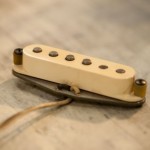Language
How To Get More Tone While Eliminating 'Wolf Tones'
Ever since the first good guitar players came into existence, they always wanted more. It could be that they wanted more sustain, more gain, more volume and/or more tone. Some of the invented methods are better when compared to others, and there are also methods that can even hurt the overall sound if you don't know what you are doing. A good example of this is the guitar pickup.
Good electric guitar players know that in order to balance the volume that is coming out from the string, they will have to adjust the adjustable poles found in the pickup. Also, if the player wants a fuller sound, this can also be achieved by moving the pickup closer to the strings. However, there is a need to be cautious as there's such as a thing as "too close."
When the pickup is too close to the string, the pickup's magnetic field starts to interfere with the string's vibration, a scenario that you don't want. So how do you know that it's too close?
The first thing to look for is for is the impediment of the string's sustain. To do this, strike a note. Then, listen to the sound carefully throughout the entire duration. As a rule of thumb, you'd want the sound to start loud and then gradually fades out. You may be able to hear a bit of "bloom" from the sound, but this is generally acceptable. However, there is a certain kind of "bloom" that is produced when the pickup is too close to the strings.
This can manifest as a twang or buzz that appears just right after the initial sound of the note and quickly disappears. Or, it can also manifest as if there's a "cloudiness" around the sound of the note.
You can also listen to the way how the sound fades out. Does it fade out naturally like in a linear fashion (more or less)? If the answer is a yes, then you should be okay.
However, if you notice that the sound quickly fades out or fades out in a non-linear fashion, then these could be symptoms produced by a pickup that is set too high.
 Best Replacement Pickups For Fender Stratocaster[/caption]
[caption id="attachment_7619" align="alignleft" width="150"]
Best Replacement Pickups For Fender Stratocaster[/caption]
[caption id="attachment_7619" align="alignleft" width="150"] A Closer Look At The Seymour Duncan Antiquity Pickup Lines[/caption]
[caption id="attachment_7620" align="alignleft" width="150"]
A Closer Look At The Seymour Duncan Antiquity Pickup Lines[/caption]
[caption id="attachment_7620" align="alignleft" width="150"] Video: Five Seymour Duncan Neck Pickups Compared[/caption]
Video: Five Seymour Duncan Neck Pickups Compared[/caption]
What Is A Wolf Tone?
Another clear indication of the pickup being too high is when the "wolf tone" is produced. A wolf tone is described as an abnormal overtone that occurs when the vibration of the string is affected by outside factors. Have you been in an instance in which the electric guitar sounds as if it's out of tune, but the guitar tuner is telling you that each string is properly tuned? If so, then it's most likely caused by the wolf tones. The way to combat this is to lower the guitar pickup until the wolf tone disappears.Final Thoughts ...
There's no exact distance between the string and pickup you can use. Each electric guitar has a lot of variables that exact measurements will rarely work. What you can do is to experiment with the distance and find that sweet spot in which the tone reaches full potential and free from unnatural sound behavior.Your Turn to Sound Off!
Have you ever had to deal with wolf tones?Let us know in the comment section below!
Other Stories You Might Like ...
[caption id="attachment_7618" align="alignleft" width="150"] Best Replacement Pickups For Fender Stratocaster[/caption]
[caption id="attachment_7619" align="alignleft" width="150"]
Best Replacement Pickups For Fender Stratocaster[/caption]
[caption id="attachment_7619" align="alignleft" width="150"] A Closer Look At The Seymour Duncan Antiquity Pickup Lines[/caption]
[caption id="attachment_7620" align="alignleft" width="150"]
A Closer Look At The Seymour Duncan Antiquity Pickup Lines[/caption]
[caption id="attachment_7620" align="alignleft" width="150"] Video: Five Seymour Duncan Neck Pickups Compared[/caption]
Video: Five Seymour Duncan Neck Pickups Compared[/caption]